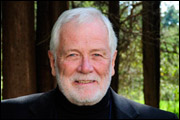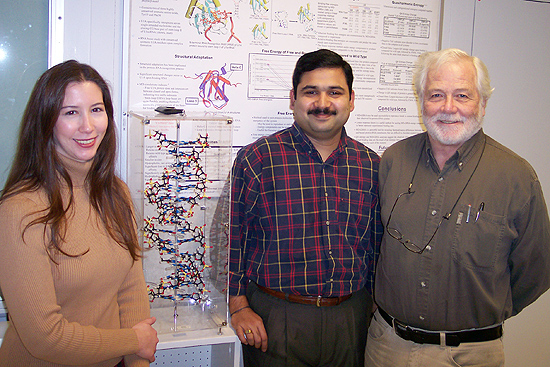| By simulating complex protein and polynucleotide structures on a supercomputer, a Wesleyan professor has been able to study one the fundamental events that lead to gene expression in biological systems.
David Beveridge, University Professor of the Natural Sciences and Mathematics, professor of chemistry, has spent the past 20 years studying various aspects of the structures, molecular motions and binding properties of DNA (deoxyribonucleic acid) and RNA (ribonucleic acid) using theoretical methods. DNA and RNA are informational macromolecules that control the composition of proteins necessary to life structures and processes.
Beveridge recently received a $241,950 Academic Research Enhancement Award from the National Institute of General Medical Sciences to continue his project “Theoretical and Molecular Dynamics Simulation Studies of U1A-RNA Binding and Specificity. U1A is an important human protein that interacts with RNA.
Biological processes involved in gene expression are all controlled by protein-DNA and protein- RNA interactions, Beveridge explains. We study the nature of these interactions at the molecular level, and how the molecules involved recognize each other with such high fidelity.
An understanding of how RNA-protein complexes form and are stabilized is important for understanding the splicing out of stretches of DNA.
Molecular dynamics simulations in this project were motivated by questions posed in experiments performed by Anne Baranger, associate professor of chemistry; and they have been collaborating on protein RNA projects for several years. Bethany Kormos, who is supported by a National Institutes of Health postdoctoral fellowship, and Surjit Dixit, senior research associate, are key coworkers on this project and really do the work, Beveridge says.
David has been a fantastic colleague to collaborate with because he is particularly talented at developing projects that aim to investigate and understand fundamental important problems in his field, Baranger explains. It has been valuable to me as an experimentalist to work with a person who has developed theoretical methods to answer questions that are difficult to achieve experimentally.
To progress in his research, Beveridge and his colleagues study the factors contributing to the stability of RNA-protein complexes with a particular emphasis on dynamical structure, the nature and significance of molecular motions involved in the complex formation.
Molecular simulations of this type are quite computationally intensive. The Beveridge group carries out their calculations with high performance computers at the National Center for Supercomputer Applications (NCSA) at the University of Illinois. The communication between Wesleyan and NCSA to run simulations involves over the Internet.
The results of a simulation are returned to laboratories at Wesleyan over the Internet and are analyzed locally for these properties using advanced computer graphics work stations.
Remote access to national supercomputer facilities enables cutting edge research in this field from even a small university vantage point, makes it possible simulate model systems quite close to those involved in experiments, Beveridge says. We can computer model systems closer to laboratory conditions than I ever dreamed of 40 years ago.
Beveridge grew up in the Sputnik Era and found the launching of the Soviet space satellite as an incentive to study science. He received his bachelors degree in chemistry from the College of Wooster in Wooster, Ohio in 1959 and his Ph.D in physical chemistry from the University of Cincinnati in 1965. Under a postdoctoral fellowship from the National Institutes of Health, he studied molecular quantum mechanics at the Centre de Mécanique Ondulatoire Appliquée in Paris, and continued his postdoctoral studies in quantum chemistry at Carnegie-Mellon University with Professor J.A. Pople, a Nobel laureate.
In addition to research and teaching, Beveridge serves as Wesleyans co-director with Ishita Mukerji of the NIH-supported graduate training program and the undergraduate certificate in molecular biophysics.
David is certainly one of the departments most successful scientists, says Mukerji, chair of the Molecular Biology and Biochemistry Department and associate professor of molecular biology and biochemistry. “He has brought much recognition to the department and to the Molecular Biophysics program.”
Beveridge has served Wesleyan as Dean of Natural Science and Mathematics for seven years and currently holds the title of University Professor of the Natural Science and Mathematics.
Beveridge has overseen a number of undergraduate research projects at Wesleyan, and has mentored both bachelor’s, master’s and Ph.D students in their dissertation research. Recent master’s graduates include Duk Blakaj 99, now a medical doctor/Ph.D student at Einstein Medical School, and Laura Vickers 05, who is currently a medical doctor student at Mount Sinai School of Medicine. Matthew Young 92, who initially worked with Beveridge as an undergraduate and continued on to get a Ph.D, has just been appointed to the faculty of the University of Michigans Medical School as an assistant professor of biological chemistry and bioinformatics. Five former research students now hold positions as college or university professors my greatest achievement, Beveridge says.
By Olivia Drake, Wesleyan Connection editor |

Professor Looks for Similarities in Science, ArtSix years ago, David Beveridge began combining teaching and personal interests in the visual arts with scholarship.
Along with Mariah Klaneski 04, he developed two classes, Science and Modernism and more recently, Science and Art. In Science and Art, interested students, even those with no particular science background, learn basic concepts in class and in the associated laboratory make paper and fresco, synthesize their own pigments using chemical reactions, make paint of various types, and use all their own materials to make original works of art.
An ultimate experience in learning by doing, Beveridge says.
Beveridges teaching at Wesleyan now ranges from topics in physical chemistry applied to biological systems to general education courses. His currently active courses at Wesleyan in addition to those mentioned above are Molecular Biophysics, and Macromolecular Modeling and Simulation.
Beveridge has more than a passing interest in the visual arts and has taken a dozen or so drawing, painting and photography courses offered by Wesleyans Graduate Liberal Studies Program and elsewhere. He is curious about the parallels between the arts and the sciences.
Both are very experimental in a sense, but make use of images in very different ways, Beveridge explains. “It is interesting to investigate the extent to which viewer response to art follows natural laws analogous to those of science, and where the similarities and differences in creative process occur between scientists and artists.”
Being at Wesleyan has given Beveridge the chance to be involved in a wide range of academic initiatives, both within the sciences and in other areas of the university.
“Im pretty much a compulsive learner, and Wesleyan accommodates my natural instinct to be a perpetual student,'” he says. |



